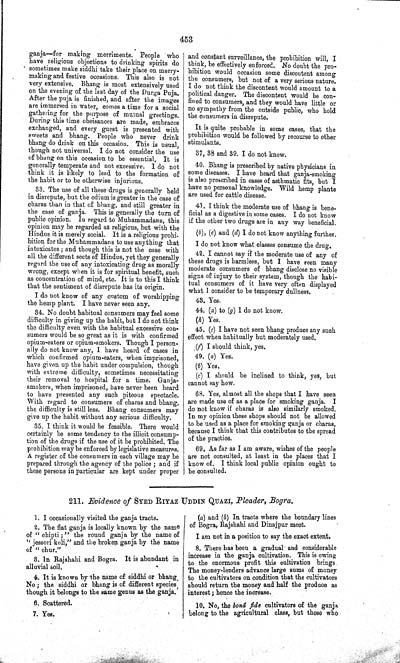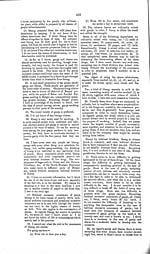Medicine - Drugs > Report of the Indian Hemp Drugs Commission, 1894-1895 > Volume IV
(467) Volume 4, Page 453
Thumbnail gallery: Grid view | List view

453
ganja—for making
merriments. People who
have religious objections to drinking spirits do
sometimes make siddhi take their place on merry-
making and festive occasions. This also is not
very extensive. Bhang is most extensively used
on the evening of the last day of the Durga Puja.
After the puja is finished, and after the images
are immersed in water, comes a time for a social
gathering for the purpose of mutual greetings.
During this time obeisances are made, embraces
exchanged, and every guest is presented with
sweets and bhang. People who never drink
bhang do drink on this occasion. This is usual,
though not universal. I do not consider the use
of bhang on this occasion to be essential. It is
generally temperate and not excessive. I do not
think it is likely to lead to the formation of
the habit or to be otherwise injurious.
33. The use of all
these drugs is generally held
in disrepute, but the odium is greater in the case of
charas than in that of bhang, and still greater in
the case of ganja. This is generally the turn of
public opinion. In regard to Muhammadans, this
opinion may be regarded as religious, but with the
Hindus it is merely social. It is a religious prohi-
bition for the Muhammadans to use anything that
intoxicates; and though this is not the case with
all the different sects of Hindus, yet they generally
regard the use of any intoxicating drug as morally
wrong, except when it is for spiritual benefit, such
as concentration of mind, etc. It is to this I think
that the sentiment of disrepute has its origin.
I do not know of any
custom of worshipping
the hemp plant. I have never seen any.
34. No doubt
habitual consumers may feel some
difficulty in giving up the habit, but I do not think
the difficulty even with the habitual excessive con-
sumers would be so great as it is with confirmed
opium-eaters or opium-smokers. Though I person-
ally do not know any, I have heard of cases in
which confirmed opium-eaters, when imprisoned,
have given up the habit under compulsion, though
with extreme difficulty, sometimes necessitating
their removal to hospital for a time. Ganja-
smokers, when imprisoned, have never been heard
to have presented any such piteous spectacle.
With regard to consumers of charas and bhang,
the difficulty is still less. Bhang consumers may
give up the habit without any serious difficulty.
35. I think it
would be feasible. There would
certainly be some tendency to the illicit consump-
tion of the drugs if the use of it be prohibited. The
prohibition may be enforced by legislative measures.
A register of the consumers in each village may be
prepared through the agency of the police; and if
these persons in particular are kept under proper
and constant
surveillance, the prohibition will, I
think, be effectively enforced. No doubt the pro-
hibition would occasion some discontent among
the consumers, but not of a very serious nature.
I do not think the discontent would amount to a
political danger. The discontent would be con-
fined to consumers, and they would have little or
no sympathy from the outside public, who
hold
the
consumers in disrepute.
It is quite probable in
some cases, that the
prohibition would be followed by recourse to other
stimulants.
37, 38 and 39. I do not know.
40. Bhang is
prescribed by native physicians in
some diseases. I have heard that ganja-smoking
is also prescribed in cases of asthmatic fits, but I
have no personal knowledge. Wild hemp plants
are used for cattle disease.
41. I think the
moderate use of bhang is bene-
ficial as a digestive in some cases. I do not know
if the other two drugs are in any way beneficial.
(b), (c) and (d) I do not know anything further.
I do not know what classes consume the drug.
42. I cannot say if
the moderate use of any of
these drugs is harmless, but I have seen many
moderate consumers of bhang disclose no visible
signs of injury to their system, though the habi-
tual consumers of it have very often displayed
what I consider to be temporary dullness.
43. Yes.
44. (a) to (g) I do not know.
(h) Yes.
45. (c) I have not seen
bhang produce any such
effect when habitually but moderately used.
(f) I should think, yes.
49. (a) Yes.
(b) Yes.
(c) I should be
inclined to think, yes, but
cannot say how.
68. Yes, almost
all the shops that I have seen
are made use of as a place for smoking ganja. I
do not know if charas is also similarly smoked.
In my opinion these shops should not be allowed
to be used as a place for smoking ganja or charas,
because I think that this contributes to the spread
of the practice.
69. As far as I am
aware, wishes of the people
are not consulted, at least in the places that I
know of. I think local public opinion ought to
be consulted.
211. Evidence of SYED RIYAZ UDDIN QUAZI, Pleader, Bogra.
1. I occasionally visited the ganja tracts.
2. The flat ganja
is locally known by the name
of "chipti;" the round ganja by the name of
"jessori koli," and the broken ganja by the name
of "chur."
3. In Rajshahi and
Bogra. It is abundant in
alluvial soil.
4. It is known by
the name of siddhi or bhang.
No; the siddhi or bhang is of different species,
though it belongs to the same genus as the
ganja.
6. Scattered.
7. Yes.
(a) and
(b) In tracts where the boundary lines
of Bogra, Rajshahi and Dinajpur
meet.
I am not in a position to say the exact extent.
8. There has been a
gradual and considerable
increase in the ganja cultivation. This is owing
to the enormous profit this cultivation brings.
The money-lenders advance large sums of money
to the cultivators on condition that the cultivators
should return the money and half the produce as
interest; hence the increase.
10. No, the bond
fide cultivators of the ganja
belong to the agricultural class, but those
who
Set display mode to: Large image | Zoom image | Transcription
Images and transcriptions on this page, including medium image downloads, may be used under the Creative Commons Attribution 4.0 International Licence unless otherwise stated. ![]()
| India Papers > Medicine - Drugs > Report of the Indian Hemp Drugs Commission, 1894-1895 > Volume IV > (467) Volume 4, Page 453 |
|---|
| Permanent URL | https://digital.nls.uk/74553184 |
|---|---|
| Description | Evidence of Bengal witnesses. |
| Description | Volume 4: Evidence of witnesses from Bengal and Assam. |
|---|---|
| Attribution and copyright: |
|




